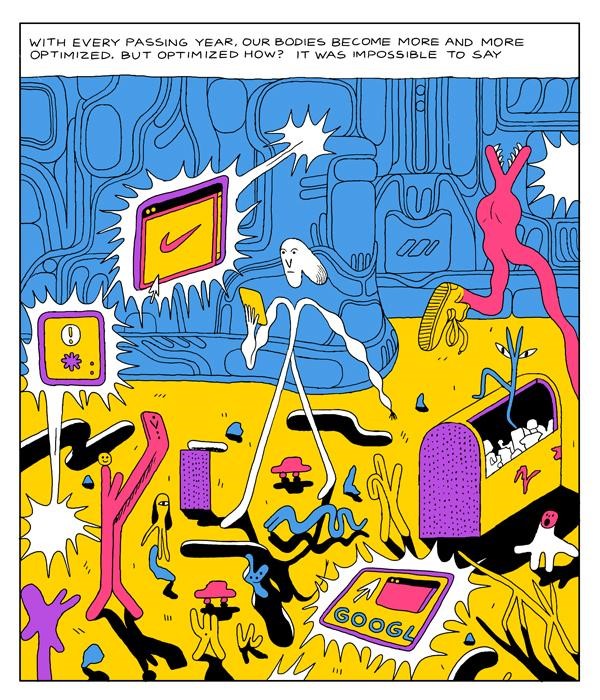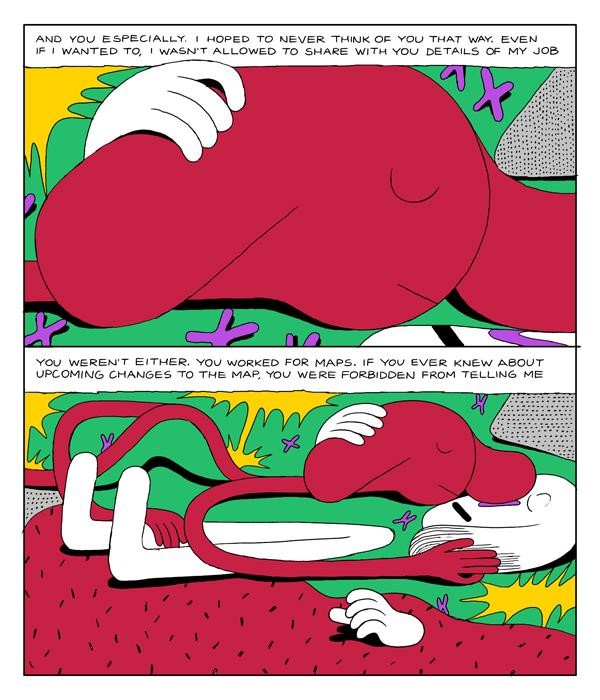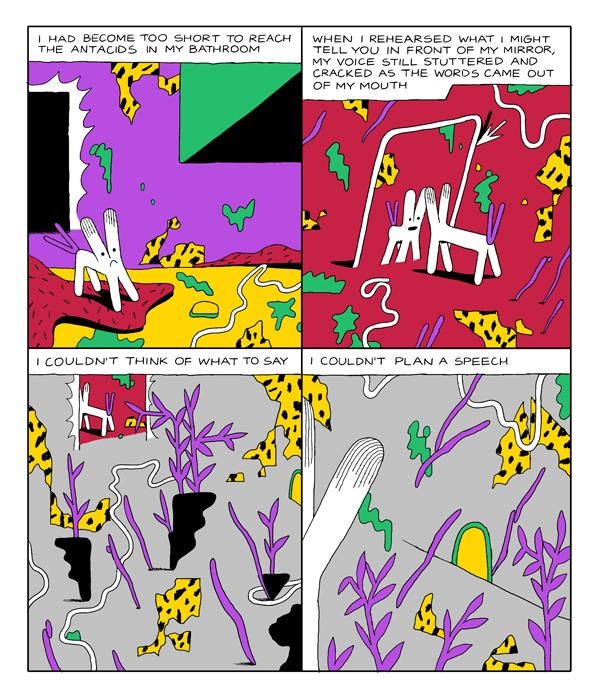
Since arriving on the comics scene with not just a bang, but with something more akin to a seismic shift some years back, Michael DeForge has been working toward something: a grand unifying statement that simultaneously addresses all his concerns, ranging from the role of the individual in the face of a collectivized social edifice, to the fluidity of identity, to technology’s usurpation of the biological. to an ultimately unresolvable longing, to old-school Cronenbergian body horror. There’s a genuine frisson of not just tension, but fear, at the heart of all of these (if you’ll forgive the term) hobby-horses, but with his latest, Familiar Face (Drawn+Quarterly, 2020), he’s taken the new and bolder approach of tying all these seemingly disparate elements together and putting his metaphorical finger on what makes them more alike than they are different. He does so by highlighting the idea of change — particularly change dished out in seemingly arbitrary fashion, and, by doing so, makes this book really goddamn scary.
I’ll give him extra credit for taking things a step further than even that, though. Given that the focus of this narrative is on a nameless protagonist/narrator whose lover disappears without explanation or readily-discernible reason, DeForge has built upon the old adage of “don’t know what you’ve got ‘till it’s gone” and has come up with something I would contend is downright sinister in its implications: “don’t know what you’ve got ‘till its gone — nor do you know why.”

Compounding this existential unease, the act of searching for someone in a largely-unaccountable technopolis becomes downright impossible when said (again nameless) technopolis is prone to random, unannounced “upgrades” that lead to buildings and streets and homes being shifted to different locales, or even “zapped” out of existence altogether. Even more horrifying, the same is true of its biological cornucopia of the inhabitants of this place, who may not look the same when they wake up in the morning as they did when they went to bed the night before. If it sounds confusing to readers, imagine how it must feel to the characters themselves.
Here’s the remarkable thing, though — DeForge’s wise choice to communicate everything via first-person narration ensures that, while the ground beneath his protagonist’s feet is always changing (hell, her feet might even be changing), the tone of the story remains consistent throughout. Someone perpetually confused as to what’s happening and why, but resigned to it as not just a part of life, but as the way of life, may seem to fit the dictionary definition of an “unreliable narrator,” but the simple fact is that in Familiar Face, the narrator herself is anything but — it’s only her circumstances that are. And, in a very real sense, her borderline-unflappability in the face of an ever-shifting world is perhaps her biggest problem of all.

This is because, as with all things DeForge, the outer is a reflection and amplification of the inner. Does our protagonist find herself single because her partner was deleted out of existence, or did her partner take her leave voluntarily and simply doesn’t want to be found? If the latter, is it for some secretive, shadowy, reason mandated by the powers that be, as the protagonist suspects, or does the truth lie far closer to home — thereby making it all the more difficult to face up to? Could she simply have been unhappy, unfulfilled, unsatisfied?
The deeper DeForge’s narrator dives into the idea of an arcane explanation for her lover’s absence, the more the reader has to wonder whether or not she’s just deluding herself more and more, refusing to accept the truth in favor of a more comfortable, and probably more interesting, fantasy. But we never know — and more crucially, she never knows. And if she is just fooling herself, then the greater the extent to which she fools herself, the more impossible it will be for her to emerge from her particular rabbit-hole.

One thing you can be certain of in any DeForge work, however, is his wonderfully inventive art that conveys tremendous unease with an ineffable sense of internal curiosity that borders on the downright playful. His minimalist line and bright, bold colors — all, as always, applied without a hint of shading or gradation — are, herein, put through the imaginative wringer: different forms tasked with expressing the same emotions, the same thought process, the same outlook. As always, the frank, stark, even monotonous narrative tone is directly at odds with the gleefully bizarre, vaguely Mark Beyer-influenced illustrations — and, as always, DeForge finds a way not so much to balance the visuals with the narrative, but to have each actively engage in conversation with the other: two extreme points along an axis poking and prodding each other almost tentatively as they work out how to not only co-exist but communicate the same information. It’s this push-and-pull between words and pictures that turns some readers off to DeForge, but for those willing to embrace it? I believe the word we’re looking for to describe it is exhilarating.
Which isn’t a bad descriptive for Familiar Face as a whole. As the culmination of a particular phase of a career, it feels very complete, very confident, as though DeForge has finally said everything he wishes to say about certain subjects that have been on his mind for a long time. It may turn out to be he has more to say about them, sure, but he’s also now very well-positioned to shift gears toward something else entirely. Either way, I’ll be along for the ride and expect to find myself challenged, entranced, absorbed, and, at times, even amused by both wherever it is we’re going, as well as how we get there.
SOLRAD is made possible by the generous donations of readers like you. Support our Patreon campaign, or make a tax-deductible donation to our publisher, Fieldmouse Press, today.

Leave a Reply